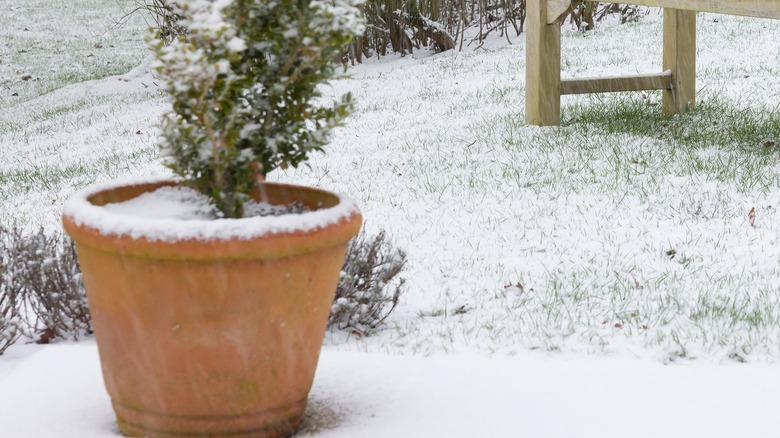TikTok Uses Gutter Tape To Save Planters From Freezing, But Is It A Good Idea?
For those living in a colder climate with precious outdoor plants, winter can be unforgiving for greenery. On TikTok, user @fluffyfeatherfarm proposed a possible solution to help his large outdoor potted plants withstand the winter cold. He wrapped his potted tree in gutter tape — an insulated heated cord intended to keep gutters from freezing throughout the winter — in hopes that it would prevent the soil in the planter from freezing and killing his tree. He used plastic stretch wrap to secure the gutter tape to the pot as he wrapped it around. While he doesn't claim that this method will work, he is hopeful that it will keep his tree alive through winter.
Though @fluffyfeatherfarm's proposal is well-intended, wrapping a heating source around an outdoor potted plant is ill-advised. Gutter tape is designed for de-icing and preventing ice dams in gutters, not providing warmth to plants. The tape may generate excessive heat, leading to root damage and dehydration. Moreover, the direct application of heat to the potting soil can disrupt the natural temperature regulation required for root development. Potted plants already have limited insulation compared to plants in the ground, making them susceptible to temperature extremes. In addition to these concerns for overall plant health, the tape poses a fire hazard if not used for its intended purpose. Utilizing heated gutter tape for potted plants can jeopardize the plant's well-being and safety. Luckily, there are other options to protect outdoor plants from winter weather.
Some better alternatives for your outdoor potted plants
While using heated gutter tape is a creative way to potentially protect plants from the cold, it isn't proven to work and should probably be avoided due to potential safety hazards. Nevertheless, insulating outdoor potted plants is crucial to shield them from winter's harsh conditions. Instead of heated gutter tape, try surrounding the pots with a layer of fresh mulch to provide effective insulation. This protective layer conserves soil moisture, reduces temperature fluctuations, and insulates roots from extreme cold. Choose an organic mulch such as straw, wood chips, or shredded leaves, applying a thick layer around the base of the plant. Mulching not only provides thermal protection but also prevents the soil from freezing and thawing rapidly.
Strategically placing potted plants in a sheltered location can help shield them from the full brunt of winter winds and extreme temperatures. Identify areas near structures like walls or fences that can act as windbreaks. Placing the pots in these sheltered spots minimizes exposure to cold drafts and reduces the risk of wind damage. Additionally, grouping potted plants together can create a microclimate that offers mutual protection.
Finally, consider wrapping the pots with insulating materials. Specialized wraps or blankets designed for plant protection can be wrapped around the exterior of the pots. These wraps provide an extra layer of insulation, preventing the potting soil from cooling too quickly. Ensure that the wrap reaches from the base of the pot to slightly above the soil level.
